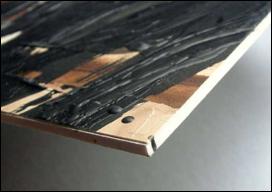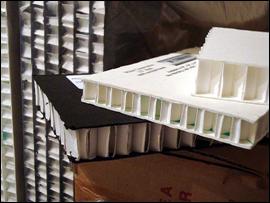 Photo 1
Photo 1
Art on 90# paper mounted to 8-ply rag, topped with encaustic.
A substrate is a surface which art is mounted to for stability and support, such as a photograph to foam center board, 8-ply rag, chip board, et al. They are required to be rigid enough to readily support whatever has been mounted to it yet neutral enough to be non-acidic, easy to cut and relatively lightweight.
Hardboard
Flat mounting is the bonding of an image to the center of a larger substrate which is then used as the decorative mat surrounding it. This technique has been popular for decades for traditional photos mounted to aluminum and poster images mounted to colored 4-ply mat board. The most common hardboard substrates are ⅛" hardboard, untempered Masonite, ¼", ½" or ¾" plywood, though Lauan, pine.
Acid content is always an issue when preservation framing so most hardboards are not well suited as a mounting substrate, that said, it is not true for every discipline. Encaustic artists most often paint on wood as wax is a fragile material which needs to be adhered to a sturdy, rigid substrate with wood being most common. The substrate supports the ground, the surface on which paint is applied, and the ground must adhere well to the support while accepting the paint—or wax—with the right degree of absorbency. Many artists cut and prepare their own ⅛" unprimed hardboard panels. Better substrates and cradles are made of Baltic birch or maple plywood, they may be purchased coated or uncoated, cradled or plain. Cradles are available both from special custom suppliers and commercially. Commercial Ampersand Hardbord is pre-sealed pressed wood which resists warping and moisture penetration, available as ⅛" flat, ¼" flat, cradled with ¾" strips, 1-½" cradle and 2" cradle. Other brands also include ¾" flat and 2-½" cradles.
Hardboards such as MDF have been favored in UK because of its rigidity and weight, which seems to give high street framing more credibility to consumers. With the advent of wide format printing and the ability to print an image to almost anything, hardboards have become more acceptable in the USA, though it is the renewable bamboo panel that has been most embraced.
8-ply Mat Board
Mat board is a multi-ply paper based product available in 4-, 6-, 8-, 10- and 12-ply thicknesses used as the natural spacer between glazing and artwork. True rag board originates from cotton linters broken down to fibers then molded into board. Museum rag board is a market phrase designed to suggest the board is a permanent, durable, stable product that would be selected by museums over rag board to safely house valuable collectibles, when actually it is most likely the same thing. Though most often used for matting, 8-ply—or thicker—rag is also used by artists as a substrate for drawing, pastel, and encaustic painting as well as a good mount board (photo 1).
 Photo 1
Photo 1
Art on 90# paper mounted to 8-ply rag, topped with encaustic.
Honeycomb Panels
On a visit to Washington DC a few years ago William Adair—frame conservator, frame historian, and master gilder— introduced me to a wonderful honeycomb panel called Tycore, which is favored by museums for mounting of valuable collectables because of its superior lightness and strength. The honeycomb interior has 7/16" cells that are the source of the board's strength and rigidity which is made of chemical pulp and adhered to alpha cellulose conservation facing boards with a polyvinyl acetate (PVA) adhesive. It is the most chemically stable fiber based honeycomb support board and is sold ¾" thick as 30"x40" and 40"x60" panels and ½" thick 48"x96" panels, both available in white only (photo 2).
 Photo 2
Photo 2
Tycore ¾" (top R); Hexamount ½" white (center) and ½" black (bottom).
Hexamount panels—a more recent development—also have hexagonal honeycomb construction with lignin-free, buffered, conservation facing paper that passes the Photo Activity Test. Both sides of the honeycomb core is surfaced with a layer of conservation board which is easily cut with sharp mat knife and metal straightedge. Available ¾" thick 30x40" and 40x60", and ½" thick 32x48" and 48x96" with either black or white virgin fiber alpha cellulose white wood pulp facing papers. This product is available in smaller sizes and is less costly because of the conservation rather than rag paper used in construction.
Panels are the perfect rigid substrate for heavy textiles, stone or marble artifacts in a shadowbox, but remember the added thickness requires more frame depth. The best news is both Tycore and Hexamount are available in the LA area through Hollinger Metal Edge, 6340 Bandini Blvd., Commerce, CA, 800-862-2228, www.hollingermetaledge.com.
END
Copyright © 2012 Chris A Paschke
For more articles on mounting basics look under the mounting section in Articles by Subject.
Additional information on all types of mounting is found in:
The Mounting and Laminating Handbook, Second Edition, 2002,
The Mounting And Laminating Handbook, Third Edition, 2008 and
Creative Mounting, Wrapping, And Laminating, 2000 will teach you everything you need to know about getting the most from your dry mount equipment and materials as an innovative frame designer.
All books are available from Designs Ink Publishing through this website.
Chris A Paschke, CPF GCF
Designs Ink
Designs Ink Publishing
785 Tucker Road, Suite G-183
Tehachapi, CA 93561
P 661-821-2188
chris@designsinkart.com